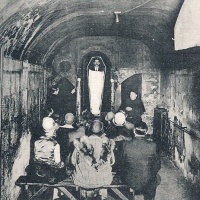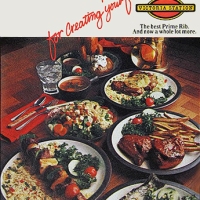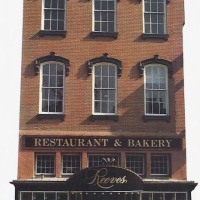 In 1910 the media was abuzz with the new Café de l’Opera on Broadway between 41st and 42nd streets in NYC. Its enormous cost and the stunning, over-the-top lavishness of its interior set a new standard for opulence on the glittering White Way. Could anyone have guessed that in a mere four months this splendid “lobster palace” would fail?
In 1910 the media was abuzz with the new Café de l’Opera on Broadway between 41st and 42nd streets in NYC. Its enormous cost and the stunning, over-the-top lavishness of its interior set a new standard for opulence on the glittering White Way. Could anyone have guessed that in a mere four months this splendid “lobster palace” would fail?
Given its fate, how perfect was it that the crowning jewel of the interior decor was a billboard-sized painting of the fall of Babylon installed prominently on a landing of the 22-ft wide staircase?
The after-theater eatery was designed to be the showplace of Times Square. It was financed by a consortium of investors that included architect/decorator Henry Erkins and John Murray, impressario of the almost-as-splendiferous Murray’s Roman Gardens, also designed by Erkins. The team sunk millions into gutting the old Saranac Hotel and turning it into a fantasy Babylonian stage set worthy of the Hippodrome. The bill for interior renovations and decor, under Erkins’ direction with Stern Brothers department store acting as general contractor, came to $1,250,000, a sum that borders on $30 million in today’s dollars.
The silver service alone cost a quarter of a million 1910 dollars, while a huge painting by Georges Rochegrosse cost something like $50,000. Er, or so it was gushingly reported. However another source claimed the painting was a copy, which is probably true. As for many of the imported ancient treasures, they were replicas cast from Middle Eastern artifacts housed in British and French museums. The gleaming black marble covering interior surfaces and pillars on the ground floor and balconies was artificial.
The interior was a startling demonstration of the transformative power of life-size statuary, concealed lighting, mirrored walls, and a million or so sheets of gold leaf. The electrical industry was thrilled with the restaurant’s flair for showcasing what miracles modern lighting could perform. But the architectural community was rather scandalized. They hid their distaste in a haze of apparent flattery, producing choked praise in which adjectives like magnificent served as insults. The “lurid and gorgeous” restaurant was so overwhelming it could “overcome at once the more sober judgment of the critic,” claimed The Architects’ and Builders’ Magazine.
 The restaurant’s dining rooms occupied four floors with its main kitchen located above them. Manager Henri Pruger, hired from the Hotel Savoy in London at the princely salary of $50,000 a year, oversaw a staff of 750. Six months after arriving in NYC he headed back home, and one can only wonder how much of his salary he managed to collect. Stern Brothers wasted no time seizing all the furnishings for auction but a goodly number of them apparently were acquired by the new owner, Louis Martin. A restaurant pro, he had formerly presided over the famed Café Martin at Broadway and 26th with his brother J. B.
The restaurant’s dining rooms occupied four floors with its main kitchen located above them. Manager Henri Pruger, hired from the Hotel Savoy in London at the princely salary of $50,000 a year, oversaw a staff of 750. Six months after arriving in NYC he headed back home, and one can only wonder how much of his salary he managed to collect. Stern Brothers wasted no time seizing all the furnishings for auction but a goodly number of them apparently were acquired by the new owner, Louis Martin. A restaurant pro, he had formerly presided over the famed Café Martin at Broadway and 26th with his brother J. B.
 Martin quickly made changes, moving the kitchen to the basement to solve the problem of food arriving cold at the tables as had happened under the previous management. He installed a bar on the first floor and eliminated the previous regime’s terrifically unpopular formal dress requirement, said to be an English notion. But the jinx was on. If ever a location reeked with bad omens, it was this. On opening night in December 1910 an employee of the Café de l’Opera started an accidental fire in a storeroom causing firemen to parade through the dining room with axes. Well, there was that foreboding fall of Babylon depicting invaders in the banquet hall. But what possessed Louis Martin to create a dining room lighted by a dozen perched owls with electrified eyes the size of silver dollars?
Martin quickly made changes, moving the kitchen to the basement to solve the problem of food arriving cold at the tables as had happened under the previous management. He installed a bar on the first floor and eliminated the previous regime’s terrifically unpopular formal dress requirement, said to be an English notion. But the jinx was on. If ever a location reeked with bad omens, it was this. On opening night in December 1910 an employee of the Café de l’Opera started an accidental fire in a storeroom causing firemen to parade through the dining room with axes. Well, there was that foreboding fall of Babylon depicting invaders in the banquet hall. But what possessed Louis Martin to create a dining room lighted by a dozen perched owls with electrified eyes the size of silver dollars?
 Martin, who ran the restaurant as Café Louis Martin, withdrew from the business in 1913. The new management renamed it the Café de Paris. On the color postcard shown here it is clear that the golden statues on the balcony are gone, replaced by flowers during this incarnation. In 1914 the Café de Paris went bankrupt and in February the restaurant’s “furniture, pictures, ornaments, rugs, carpets, curtains, linen, tableware, kitchenware, and other equipment and furnishings” were auctioned. The building was razed in 1915.
Martin, who ran the restaurant as Café Louis Martin, withdrew from the business in 1913. The new management renamed it the Café de Paris. On the color postcard shown here it is clear that the golden statues on the balcony are gone, replaced by flowers during this incarnation. In 1914 the Café de Paris went bankrupt and in February the restaurant’s “furniture, pictures, ornaments, rugs, carpets, curtains, linen, tableware, kitchenware, and other equipment and furnishings” were auctioned. The building was razed in 1915.
© Jan Whitaker, 2011












 It's great to hear from readers and I take time to answer queries. I can't always find what you are looking for, but I do appreciate getting thank yous no matter what the outcome.
It's great to hear from readers and I take time to answer queries. I can't always find what you are looking for, but I do appreciate getting thank yous no matter what the outcome.



Is there any resource I might find copy of menu from cafe de opera??? I would much appreciate ☺
You could search the New York Public Library’s online menu collection or set up an alert on e-Bay so you would be notified if one shows up for sale there.
I own an unopened bottle of Creme De Menthe Glaciale that has a sticker on it, saying it is ‘specially imported for The Cafe Del’Opera New York ‘ on it. It is very old, was passed down from great grandparents. Any idea if it would be worth anything? I’d assume probably not, but I’ve always been curious.
Well, I think that’s pretty cool, but I doubt it would have much monetary value. Did your grandparents have any stories to go with it.
Dear Amanda, do u still have it ? I might would be interested to buy it it has spiritual value to me.
Best regards
Pingback: The Smiths of Bridgeport | queenofsienna
if interested, I’ll send you a copy of an article published in Le Matin, in France, on April 19, 1912, mentioning the restaurant Louis Martin as the place where three French Titanic survivors went to drink Champagne and sing La Marseillaise (the French national anthem) just after disembarking from the Carpathia. Alfred Fernand Omont, Pierre Maréchal and Paul Chevré were led by a very well known French reporter, François de Tessan
I’d love to see it — thanks.
hello, sorry for replying so late. Here is an excerpt from Le Matin, dated April 19, 1912, where François de Tessan, the French reporter, mentions the restaurant Louis Martin. Do you want me to send you the whole article ? It is very long. I’ll see if I can get a scan of the front page where the restaurant is mentioned. Can I send documents along with my comments here or will you have to give me an email address so I can do it ? Thanks so much for your reply. Olivier
Thanks. My email is
janwhitaker@verizon.net
From Le Matin, April 19, 1912
Ceux pour qui le « Carpathia » ne ramène personne
D’autres passent, silencieux, mornes, désespérés : ce sont ceux qui n’ont pu retrouver la moindre trace des êtres qui leur étaient chers.
Ils ont espéré jusqu’à la dernière minute, mais, hélas ! tout est bien fini maintenant.
Ah ! pourrai-je jamais oublier ce sombre défilé de veuves, d’aïeules, de vieillards, d’orphelins ? Cortège inouï des épaves humaines du plus grand désastre maritime…
J’entraîne nos rescapés français.
Nous sautons en auto et nous allons, pour tâcher d’oublier un instant toutes ces misères, boire un verre de Champagne au restaurant Louis Martin.
Certes, ils n’auraient jamais supposé, quelques heures auparavant, qu’ils videraient une coupe de vin de France.
Une émotion intense s’empare de nous tous : nous entonnons la Marseillaise, pour nous réconforter, et notre chant héroïque prend, à nos yeux, une signification poignante : c’est un hymne sacré, qui dit tout le bonheur qu’éprouvent des êtres ayant désespéré de tout, enfin rendus à la vie après un affreux cauchemar.
Le Carpathia ramène 700 survivants.
ditto!!
You find the best stuff!!!